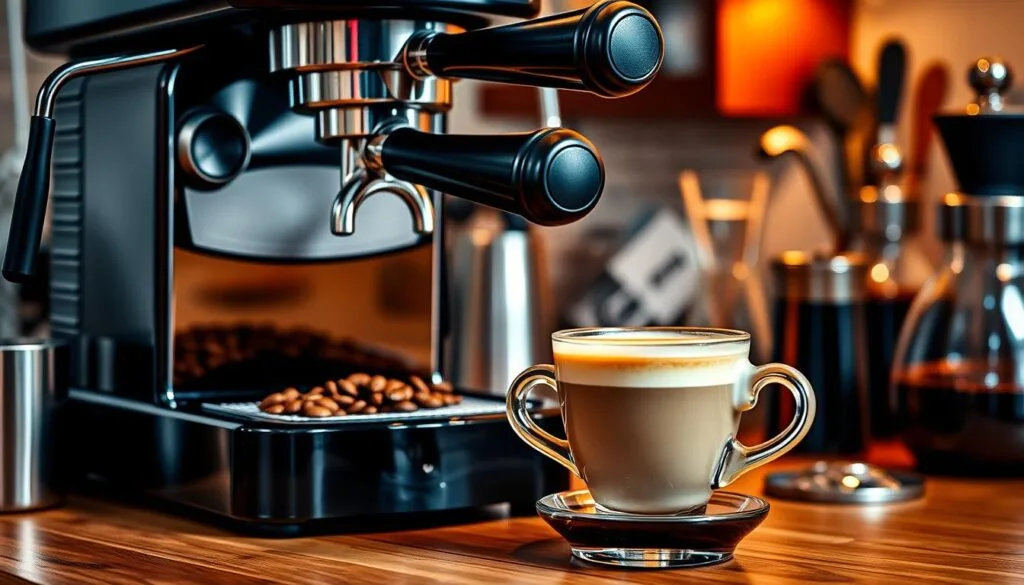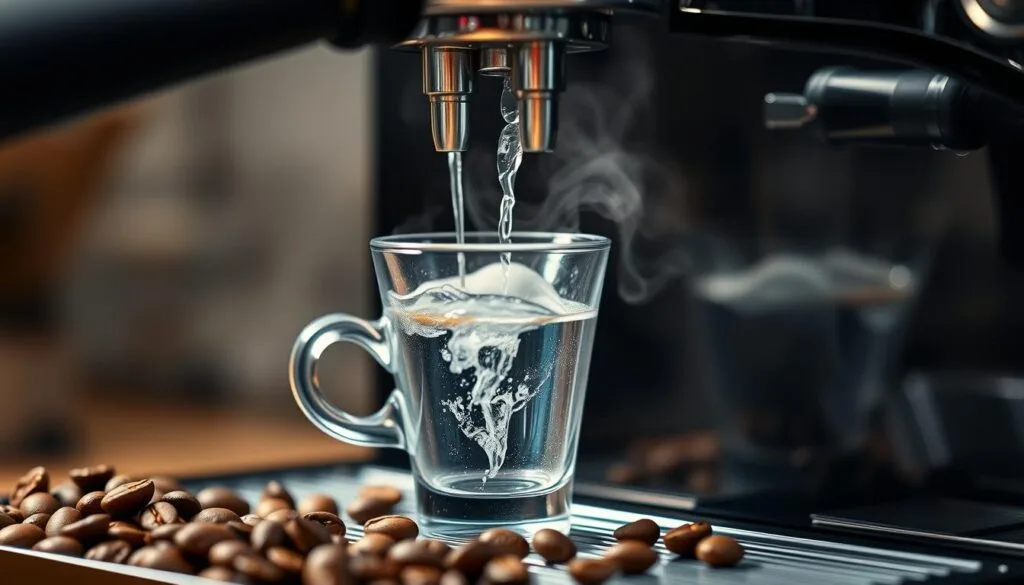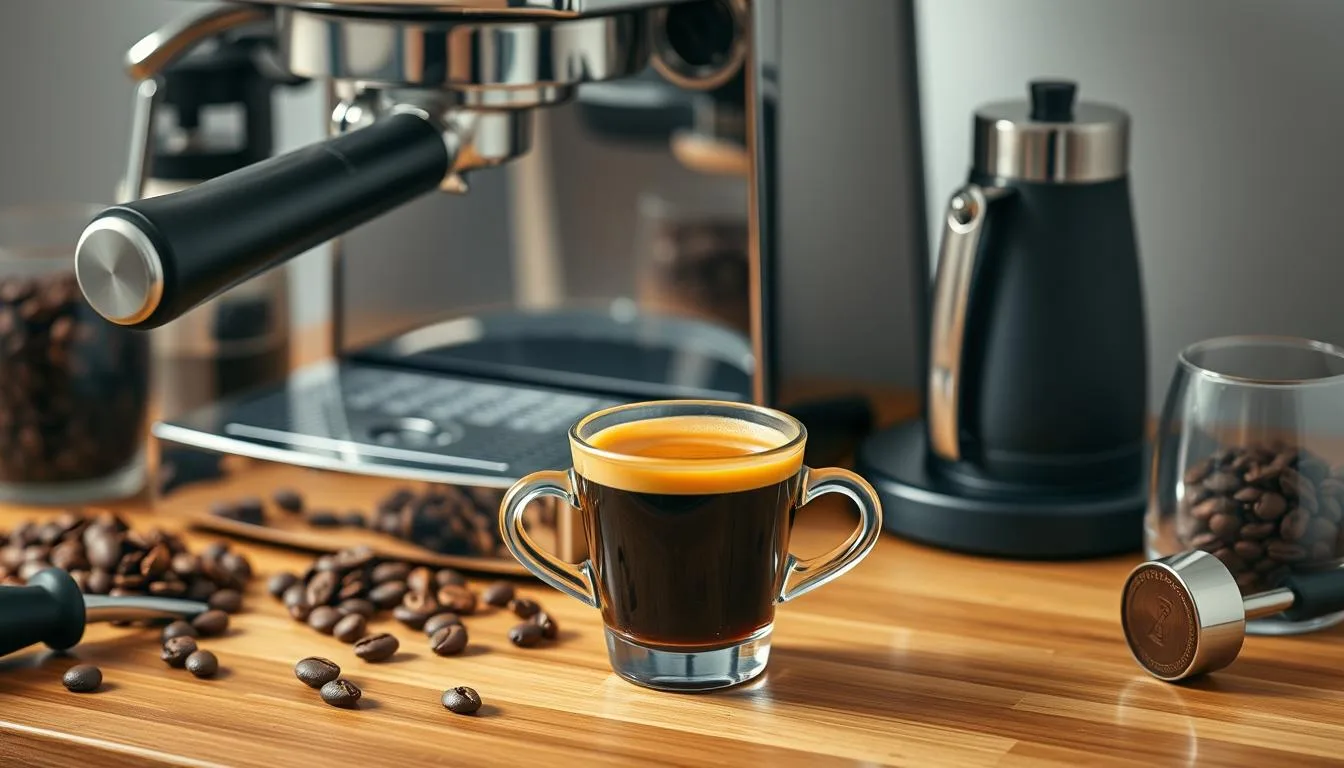Learn the best espresso recipe for a perfect shot every time
Every morning, I stand before my espresso machine, waiting for that magical moment. It’s when precision turns simple coffee grounds into liquid gold. Making the perfect espresso is more than just pressing a button. It’s an art that mixes science, skill, and passion.
An espresso is not just coffee. It’s a strong brew made by forcing hot water through fine coffee grounds at high pressure. When made just right, you get a rich, golden-brown crema. This crema shows off the skill of the maker.
Starting your espresso journey means learning about its key parts. From picking top-quality coffee beans to adjusting brewing details, each step is important. Together, they create a unique taste experience.
Table of Contents
Understanding Espresso: The Foundation of Coffee Perfection
Espresso recipe is a unique and concentrated coffee experience. It turns regular brewing into an art form. This intense drink offers a rich, complex flavor in a small, powerful shot.
Explore the world of espresso and see why it’s so special. The espresso drink chart shows the details that make it different from regular coffee.
What Makes Espresso Unique
- Concentrated extraction using high pressure
- Precise brewing technique
- Shorter brewing time compared to regular coffee
- Intense flavor profile
Historical Journey of Espresso
Espresso recipes started in Italy in the early 1900s. It was a new way to brew coffee. Luigi Bezzera created the first espresso machine, using pressurized water to brew coffee quickly.
By the 1940s, lever machines made espresso-making even better. They helped start the modern coffee culture.
“Espresso is not just a drink, it’s a cultural experience.” – Italian Coffee Master
Key Components of a Quality Espresso Shot
| Component | Specification |
|---|---|
| Shot Volume | 1 oz (30 ml) |
| Coffee Grounds | 6-8 grams |
| Extraction Time | 24-30 seconds |
| Water Temperature | 190-202°F (88-94°C) |
| Extraction Pressure | 9 bar |
Every espresso shot is a story of precision, passion, and perfection. The espresso drink chart helps you see the balance of elements that make this drink so special.
Essential Equipment for Brewing Professional-Grade Espresso
Making the perfect espresso drink needs more than just love—it requires the right tools. Your home coffee setup can turn a simple morning into a special experience.
Creating a great espresso starts with knowing the key tools that improve your brewing. Professional-grade equipment helps you move from amateur to expert coffee maker.
Selecting the Right Espresso Machine
Choosing the right espresso machine is key for consistent results. Machines vary in features to fit different skills and tastes:
- Manual machines: Perfect for those who love to get their hands dirty
- Semi-automatic machines: Offer a mix of control and ease
- Super-automatic machines: Make brewing easy with just one touch
Most home espresso machines work at about 9 bars of pressure. Top models can go up to 15 bars. The best brewing temperature is between 195-205°F. This is crucial for getting the best flavor from your coffee beans.
Grinder Types and Quality Impact
A good grinder is a hidden hero in espresso making. Burr grinders give consistent grind size, which greatly affects the quality of your espresso.
| Grinder Type | Grind Settings | Precision Level |
|---|---|---|
| Breville Barista Express | 25 settings | Good |
| Breville Smart Grinder Pro | 60 settings | Excellent |
Essential Accessories for Home Baristas
Complete your espresso machine with these essential tools:
- Precision brew scales
- Quality tamper
- Milk frothing pitcher
- Milk thermometer
- Knock box
“The right tools turn coffee making into an art form.”
Pro tip: Choose equipment that fits your skill level and love for espresso. Quality tools make a big difference in your brewing journey.
Selecting the Perfect Coffee Beans for Espresso recipe
Choosing the right coffee beans is key for great iced espresso and hot espresso. The flavor of your espresso can change a lot with the right beans. It’s a big step in making the perfect shot.
When picking espresso beans, think about these important points:
- Roast level: Medium to medium-dark roasts are best for espresso
- Bean origin: A mix of Brazilian and Ethiopian beans can add complex flavors
- Freshness: Use beans within 7-21 days after roasting for the best taste
Arabica vs. Robusta: Most espresso fans choose 100% Arabica beans for their rich flavors. Arabica beans have a sweet taste and complex notes. Robusta adds a strong taste and thicker crema.
“The perfect espresso recipe begins with selecting the right beans” – Professional Barista
For iced espresso, look for beans with bright, crisp flavors like citrus, toffee, or dark chocolate. Brazilian coffees are sweet, while Ethiopian beans add interesting stone fruit notes.
Quality espresso beans come at different prices:
- Budget-friendly: Lavazza Espresso at $0.43 per ounce
- Mid-range: Allegro Organic Espresso at $1.00 per ounce
- Premium: Onyx Coffee Lab Monarch at $1.94 per ounce
Grind your beans just before brewing for the freshest iced espresso.
The Ultimate Espresso Recipe for Home Baristas
Making the perfect espresso at home needs precision, passion, and practice. Your journey to becoming a home barista begins with understanding the details of a great espresso recipe.

To create an outstanding espresso recipe, you must master several key elements. Let’s explore the essential components that will enhance your home brewing experience.
Precise Measurements and Ratios
The base of a fantastic espresso recipe is in precise measurements. Here are the key ratios to remember:
- Coffee dose: 18-20 grams for a double shot
- Espresso yield: 36-40 grams
- Extraction time: 25-30 seconds
Step-by-Step Brewing Instructions
- Select fresh coffee beans roasted within the last 6 weeks
- Grind beans to a fine consistency (similar to powdered sugar)
- Distribute ground coffee evenly in the portafilter
- Apply consistent tamping pressure (approximately 30 lbs)
- Pull the shot at the optimal temperature (190°F to 205°F)
Timing and Temperature Control
Precision is key in your espresso recipe. Keep an eye on these important parameters:
| Parameter | Ideal Range |
|---|---|
| Brewing Temperature | 190°F – 205°F |
| Extraction Time | 25-30 seconds |
| Coffee Grind | Fine, like powdered sugar |
Pro tip: Invest in a precision scale that measures to 0.1 grams for consistent results in your espresso recipe.
“The art of espresso is in the details, not the drama.” – Unnamed Coffee Master
Mastering the Art of Grinding and Tamping
Making great espresso drinks starts with two key skills: grinding and tamping. These skills are crucial because they turn regular coffee beans into a delicious liquid.
Choosing the right grinder is your first important step. Burr grinders give you consistent grind size, which is key for a perfect shot. Blade grinders make uneven particles that hurt the shot’s quality.
“Precision in grinding is the foundation of extraordinary espresso.” – Professional Barista Wisdom
Grinding Essentials
- Use a single-dose burr grinder for maximum freshness
- Aim for a grind finer than table salt
- Grind beans within 6 weeks of roasting
- Avoid retaining stale grounds between uses
Tamping Techniques
Tamping makes loose grounds into a tight coffee bed. Use about 30 pounds of pressure to make sure water flows evenly.
| Tamping Parameter | Recommended Value |
|---|---|
| Pressure | 30 pounds |
| Consistency | Uniform across entire coffee bed |
| Angle | 90 degrees to portafilter |
By mastering these techniques, your espresso drinks will have deep flavor, perfect crema, and top-notch quality every time.
Water Quality and Temperature Considerations
Making a great espresso is more than just grinding beans and pressing a button. Water is key to the taste and quality of your espresso. In fact, water makes up about 90% of every espresso shot.

The Specialty Coffee Association (SCA) has clear guidelines for making the perfect espresso. They found several important factors that affect your success:
- Optimal brewing temperature range: 195°F to 205°F
- Recommended Total Dissolved Solids (TDS): 70-120 ppm
- Ideal water mineral balance: Moderately soft water
Optimal Water Properties
The minerals in your water greatly affect the taste of your espresso. Filtered or bottled water can remove unwanted minerals and chlorine. Look for water with a balanced mineral content that supports rich extraction without harsh undertones.
Temperature Impact on Extraction
Getting the temperature right is crucial for extracting the best flavors. Temperatures below 195°F can make the espresso sour. Temperatures above 205°F might make it bitter. Baristas aim for 195°F to 205°F to get the best flavor.
Maintaining Consistency
Keeping the water temperature consistent is important. It ensures every espresso drink is of high quality. Invest in an espresso machine with precise temperature control for consistent flavor.
“Water is the soul of your espresso – treat it with respect.” – Professional Barista Wisdom
Common Espresso Drinks and Variations
Espresso is more than just a shot of coffee. It’s a canvas for creativity, offering a wide range of drinks for coffee lovers. Your espresso drink chart shows how versatile this concentrated coffee is.
Let’s dive into the most popular espresso-based drinks that will take your coffee game to the next level:
- Classic Hot Espresso Drinks
- Cappuccino: A mix of espresso, steamed milk, and foam
- Latte: A shot of espresso with lots of steamed milk
- Americano: Espresso mixed with hot water
- Macchiato: Espresso with a hint of milk foam
As summer heats up, iced espresso drinks offer a cool and refreshing twist. They keep the rich espresso flavor but with a cool twist:
- Iced Espresso Drinks
- Iced Latte: Espresso over ice with cold milk
- Iced Americano: Espresso and cold water over ice
- Iced Mocha: Espresso, chocolate, and cold milk
- Cold Brew with Espresso Shot: A caffeine boost
| Drink | Espresso Quantity | Additional Ingredients | Caffeine Content |
|---|---|---|---|
| Espresso Shot | 1 oz | None | 64 mg |
| Cappuccino | 1 oz | Steamed milk, foam | 64 mg |
| Iced Latte | 1 oz | Cold milk, ice | 64 mg |
“Espresso is not just a drink, it’s an art form that transforms simple ingredients into extraordinary experiences.” – Coffee Enthusiast
Whether you like your espresso hot or cold, there’s a drink for you. Try these variations and find your new favorite espresso drink!
Troubleshooting Common Espresso Problems
Making the perfect espresso takes patience and skill. Even pros face issues that can affect their coffee’s quality. Knowing how to fix these problems will make you better at making espresso.
Addressing Extraction Issues
Getting the right espresso extraction can be hard. Many users face bitter or sour shots. These problems usually come from wrong extraction methods. Here are some signs to look out for:
- Over-extraction (Bitter Taste): Water goes through the grounds too slowly
- Under-extraction (Sour Taste): Water moves through the grounds too quickly
Flavor Balance Adjustments
Getting the perfect espresso recipe needs careful adjustments. Try these tips:
- Change the grind size a little at a time
- Make sure your tamping is consistent
- Keep the extraction time between 25-30 seconds
Machine-Related Solutions
Most espresso machine problems come from not taking care of it. Regular maintenance can solve most issues:
- Clean the machine parts every day
- Descale every 3-6 months
- Check the water pressure and temperature
“Consistent maintenance is the secret to long-lasting espresso equipment.”
By learning these troubleshooting tips, you can turn espresso recipe problems into chances to get better.
Tips for Achieving the Perfect Crema
Crema is the golden touch that makes an espresso shot special. It turns a simple drink into a feast for the senses. Learning to make perfect crema can take your coffee-making skills to new heights.
Creating rich, velvety crema requires a few key things:
- Use freshly roasted coffee beans within 2-3 weeks of roasting
- Select medium to dark roast beans with Robusta blend
- Maintain consistent grinding techniques
- Ensure proper tamping pressure between 20-30 pounds
The secret to crema is in the science of extraction. Your espresso machine needs to pressurize at 9 bar and heat the water to 190-202°F. A shot should use 6-8 grams of ground coffee, brewed in 24-30 seconds.
“Great crema transforms an ordinary espresso into a liquid masterpiece” – Professional Barista Insight
When making espresso drinks, remember crema’s role in taste and looks. A golden-brown crema means the coffee is extracted just right. This promises a balanced, rich flavor that coffee lovers adore.
Don’t worry if it takes time to get it right. Baristas say it might take 5-7 tries to perfect crema. So, keep trying and don’t get discouraged.
Conclusion
Your espresso recipe adventure is more than just brewing a drink. It’s about understanding the art and science behind each shot. The U.S. coffee culture loves espresso, showing a deep appreciation for quality and precision.
Mastering an espresso drink takes patience, practice, and a desire to try new things. From picking the right Arabica beans to perfecting your tamping, every step is important. Whether you’re making a classic shot or trying out cappuccinos and macchiatos, your skills will grow with each brew.
Great espresso isn’t just about following rules. It’s about knowing how beans, water, pressure, and technique work together. As you get better, you’ll find that the best espresso comes from knowledge, passion, and your own touch.
Start your journey to becoming a home barista. Your hard work and willingness to learn will turn simple coffee beans into amazing espresso experiences. These will be just as good as those found in professional cafes across the U.S.
FAQ
What exactly is espresso?
How is an espresso shot different from regular coffee?
What equipment do I need to make espresso at home?
What type of coffee beans are best for espresso?
How do I know if I’m extracting espresso correctly?
What are some popular espresso-based drinks?
Can I make espresso without an expensive machine?
How important is water quality in making espresso?
What’s the secret to creating great crema?
How can I troubleshoot common espresso-making problems?
have you tried our recipe?
There are no reviews yet. Be the first one to write one.


